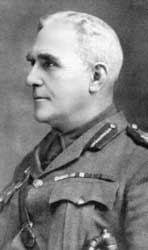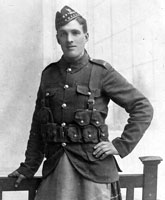Canada Takes the Lead in Modern Infantry Equipment
 According to Albert Lethern's account in The Development of the Mills Woven Cartridge Belt 1877-1956, Canada was a tough sell for the Mills Equipment Company's new Mills-Burrowes Equipment. The Minister of Militia and Defence, Sir Frederick William Borden (KCMG 1902), was determined to modernise the
According to Albert Lethern's account in The Development of the Mills Woven Cartridge Belt 1877-1956, Canada was a tough sell for the Mills Equipment Company's new Mills-Burrowes Equipment. The Minister of Militia and Defence, Sir Frederick William Borden (KCMG 1902), was determined to modernise the  Canadian Military, but he was also committed to maintaining Canadian identity and, wherever possible, the use of Canadian equipment and accoutrements. Canadian trials of W.E. Mills-Burrowes were held in 1907 by all companies of the Royal Canadian Regiment. The resultant reports were uniformly negative. As always though, M.E. Co. persisted and, after numerous tests and negotiations, a special Canadian version of Web Equipment, Pattern 1908 was entered into the Canadian List of Changes as C.L. of C. §447, dated 1st September 1910. This variation of W.E. Patt. '08 is discussed on the Patt. '08 Cartridge Carriers page. Canada purchased limited quantities of the new Canadian Patt. '08 over the next two years, but in 1911 Sir Frederick was replaced as Minister of Militia and Defence by General Sam Hughes (later Sir Samuel Hughes, KCB 1915). "Sir Sam", as he was known (photo right), was vehement in insisting on the use of Canadian military equipment, promoting the use of, among others, the Ross Rifle, the Pattern 1899 Canadian Infantry Equipment (so-called “Oliver Pattern”, though more correctly it was Valise Equipment, Oliver Pattern), and the legendary MacAdam Shield Shovel. Albert Lethern reports that, in a meeting between Sir Samuel Hughes, William Wise, and Major Burrowes at the Savoy Hotel, Mr. Wise even did his ever-popular parlour trick of walking across the room "on his hands" wearing a fully loaded set of W.E. Patt. '08, in order to demonstrate the balance of the equipment1. Sir Sam was not impressed.
Canadian Military, but he was also committed to maintaining Canadian identity and, wherever possible, the use of Canadian equipment and accoutrements. Canadian trials of W.E. Mills-Burrowes were held in 1907 by all companies of the Royal Canadian Regiment. The resultant reports were uniformly negative. As always though, M.E. Co. persisted and, after numerous tests and negotiations, a special Canadian version of Web Equipment, Pattern 1908 was entered into the Canadian List of Changes as C.L. of C. §447, dated 1st September 1910. This variation of W.E. Patt. '08 is discussed on the Patt. '08 Cartridge Carriers page. Canada purchased limited quantities of the new Canadian Patt. '08 over the next two years, but in 1911 Sir Frederick was replaced as Minister of Militia and Defence by General Sam Hughes (later Sir Samuel Hughes, KCB 1915). "Sir Sam", as he was known (photo right), was vehement in insisting on the use of Canadian military equipment, promoting the use of, among others, the Ross Rifle, the Pattern 1899 Canadian Infantry Equipment (so-called “Oliver Pattern”, though more correctly it was Valise Equipment, Oliver Pattern), and the legendary MacAdam Shield Shovel. Albert Lethern reports that, in a meeting between Sir Samuel Hughes, William Wise, and Major Burrowes at the Savoy Hotel, Mr. Wise even did his ever-popular parlour trick of walking across the room "on his hands" wearing a fully loaded set of W.E. Patt. '08, in order to demonstrate the balance of the equipment1. Sir Sam was not impressed.
Given this opposition, it is remarkable that the Mills Company were able to convince the Canadian Militia Council, in 1913, to accept the very latest M.E. Co. design of advanced infantry web equipment, "Back-Adjustment Mills-Burrowes Equipment". In point of fact, Lethern records  "…Efforts were made…, but without success…"2 , which was clearly not the case. The introduction of the charger loaded Ross Rifle Mk. III was certainly a factor, but the negotiations to achieve this goal must have been intense. Web Equipment, Pattern 1913 was entered into the Canadian List of Changes under C.L.C. §1203 [no date but 1913]. The new pattern embodied all of the Mills Company's latest innovations. The first Mills Company Back-Adjustment Equipment to be authorised in the Empire, Patt. '13 featured separate Carriers, ammunition, connected by a Strap, adjustment; a unique Carrier, waterbottle (which combined the intrenching tool & water bottle carrier into one unit) and reduction weave Braces, whose lighter 1-inch straps and buckles replaced the 2-inch versions of Patt. '08.
"…Efforts were made…, but without success…"2 , which was clearly not the case. The introduction of the charger loaded Ross Rifle Mk. III was certainly a factor, but the negotiations to achieve this goal must have been intense. Web Equipment, Pattern 1913 was entered into the Canadian List of Changes under C.L.C. §1203 [no date but 1913]. The new pattern embodied all of the Mills Company's latest innovations. The first Mills Company Back-Adjustment Equipment to be authorised in the Empire, Patt. '13 featured separate Carriers, ammunition, connected by a Strap, adjustment; a unique Carrier, waterbottle (which combined the intrenching tool & water bottle carrier into one unit) and reduction weave Braces, whose lighter 1-inch straps and buckles replaced the 2-inch versions of Patt. '08.
Surviving examples of Patt. '13 are uncommon today. The famous photograph reproduced at the start of this article shows Princess Patricia's Canadian Light Infantry (aka 'Pat's Pets') on parade wearing W.E. Patt. '13, just after the battalion's arrival in England in 1914. The recently discovered photo at left, now in the Karkee Web Collection, shows a soldier from an unidentified Canadian Scots regiment. In Tangled Web, Brig. Jack Summers states:
WE'13 Pattern had been issued to Canada's regular soldiers including the Royal Canadian Regiment, Canadian Garrison Artillery Units, and some of the dismounted service units. Also, Princess Patricia's Canadian Light Infantry, a battalion composed of experienced soldiers, was issued with the WE'13 Pattern and wore it to France in December 1914 while the battalion was attached to the British 80th Infantry Brigade.
The fact that existing stocks of both WE'08, Canadian Pattern, and WE'13 were issued to units proceeding overseas probably accounts for the almost total absence of these uniquely Canadian patterns of web equipment from Canadian collections.3
Karkee Web has not been able to locate anyone who has a complete set of Web Equipment, Pattern 1913. The photographs shown in the W.E. Patt. '13 Components Page are mostly from the collection of noted Canadian accoutrementalist Ed Storey, supplemented with pictures of the few items in the Karkee Web collection.
Footnotes:
1. Lethern, Albert. The Development of the Mills Woven Cartridge Belt 1877 - 1956. London. n.d. [1956], p. 34.
2. Lethern, Albert. op. cit., p. 34.
3. Summers, Jack L. Tangled Web: Canadian Infantry Accoutrements 1855 - 1985. Canadian War Museum Historical Publication No. 26, Museum Restoration Service, Canada & USA, 1991, p. 65.